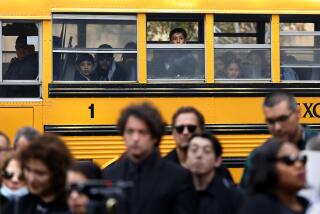Newspapers Courting the MTV Generation : Sections for teen-agers seen as print journalism’s hope for future. Results are watched closely by industry.
WASHINGTON — Fearful about where their next generation of readers will come from, newspapers are beginning to redesign parts of their papers for an audience that supposedly is not interested in reading--teen-agers. And there are signs it is working.
Most of the efforts are at smaller and medium-size papers--such as the daily Kentucky Kid in the Lexington Herald-Leader or the weekly Alligator Express in the St. Petersburg Times in Florida.
The experiment is still limited--the American Newspaper Publishers Assn. lists just 24 newspapers producing local sections, pages or features for the young. But few efforts in American journalism are being more closely watched or are seen as having as much potential impact on whether the daily newspaper will ultimately survive.
BACKGROUND: The problem, now familiar, is that younger Americans are not reading. According to the Newspaper Advertising Bureau, the percentage of people 30 to 44 years old who read a newspaper every day has dropped from 75% in 1972 to 45% in 1989.
And the percentage of readers 18 to 24 has dropped from 73% in 1970 to 53% in 1990.
One of the first papers to address the problem by starting a section for teen-agers was the Syracuse Herald-Journal in October, 1989.
“These are our future readers, and we are not doing a lot to entice them into the newspaper,” said Arts Editor Grant Podelco, paraphrasing the paper’s thinking at the time.
Other papers began to aim at young readers during the Persian Gulf War. “Our concept was to set up a page for kids that talked about the roots of the war, the region, the history,” said Bill Zimmerman, Newsday’s assistant business editor at the time and the author of several books on children. He helped start a Student Briefing Page on the News. The Long Island paper’s youth page is more closely tied to news than are the other youth sections, which generally are theme oriented.
Many other papers, including the Los Angeles Times, as well as a committee of the American Society of Newspaper Editors, have recently produced prototypes to explore youth sections.
THE CONCEPT: The idea is not new. Features aimed at young readers were common in the 1950s, but they began to disappear in the 1960s, according to Chris Lavelle, features editor of the Phoenix Gazette in Arizona--perhaps the only paper to have produced a youth section, called Teen Gazette, uninterrupted for 40 years.
But the newest youth sections--usually heavy on color and graphics for the video generation--are generally more substantial in size (Ft. Worth runs 16 to 20 pages a week) and sophisticated in approach.
In Syracuse, editors began by meeting with teen-agers, who told the editors that the section should be local, not national, should talk about their schools, their friends. The paper hired student correspondents from each of the 30 local high schools, plus TV, film and food reviewers.
The Herald-Journal section, called hj, is written with a rebellious voice, and, to the alarm of some adults, recent issues have focused on such controversial topics as how to use birth control and have explored the stereotypes about each of the local high schools.
On Thursdays, when hj comes out, the paper, with a usual weekday circulation of 95,000, distributes an extra 27,000 copies to high schools.
In Ft. Worth, the graphics-laden and full-color section in the Star-Telegram for young readers, called Class Acts, is more national in scope (although 35% is local school news written by students) and includes advice columns, fashion, music and generous amounts of entertainment coverage. One reason is that the paper is trying to profit by syndicating Class Acts material through the New York Times.
The weekly Ft. Worth section has borrowed heavily from rock radio stations and MTV by mixing the editorial content with promotion and marketing; it averages 75 contests a year.
The paper sells an extra 15,000 copies every Tuesday to local schools, and Class Acts is run as a profitable independent business.
At Newsday, Zimmerman, who edits the paper’s youth section, also believes in making the pages “interactive.” Half of the section is made up of student responses to appeals for poetry, letters and opinions.
THE OUTLOOK: “Newspapers today have to find creative ways to reach people when they’re young to retain them as future readers,” Zimmerman said.
“How many newspapers can claim to have received 6,000 letters (in five months) just from one new feature?”
More to Read
Inside the business of entertainment
The Wide Shot brings you news, analysis and insights on everything from streaming wars to production — and what it all means for the future.
You may occasionally receive promotional content from the Los Angeles Times.










